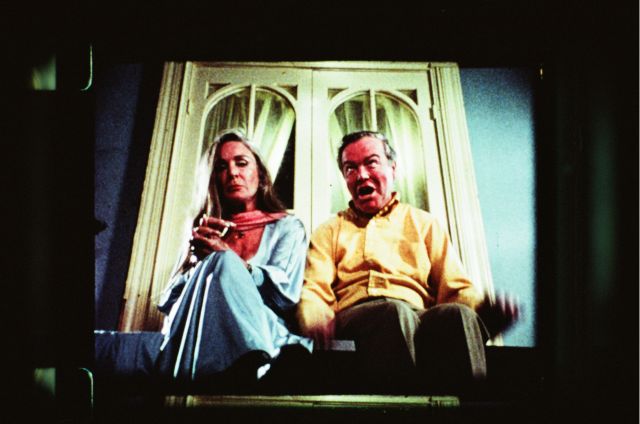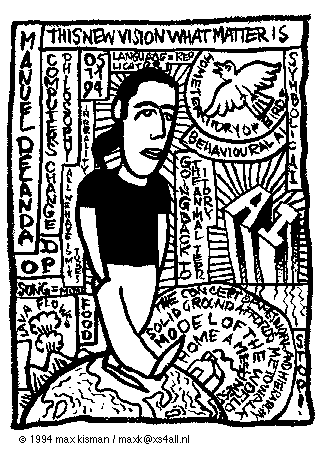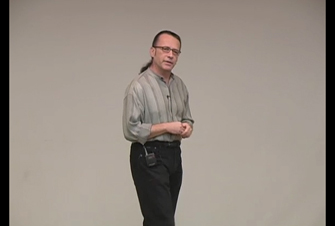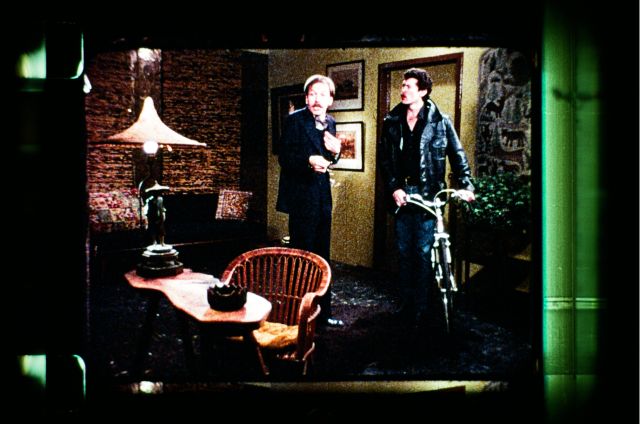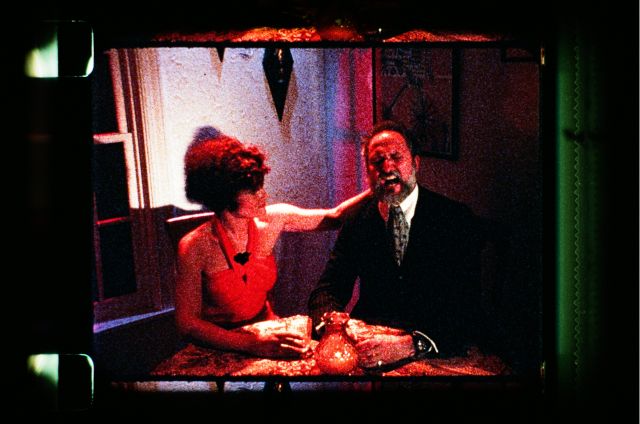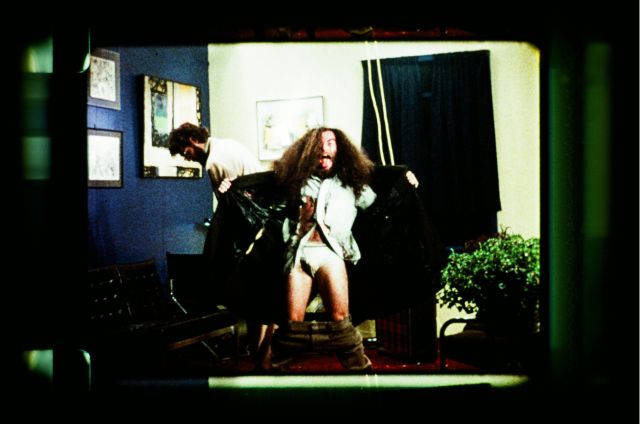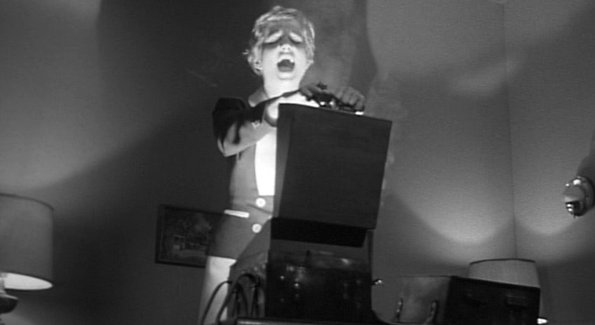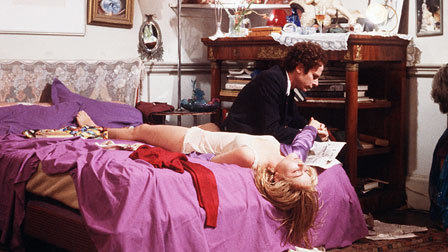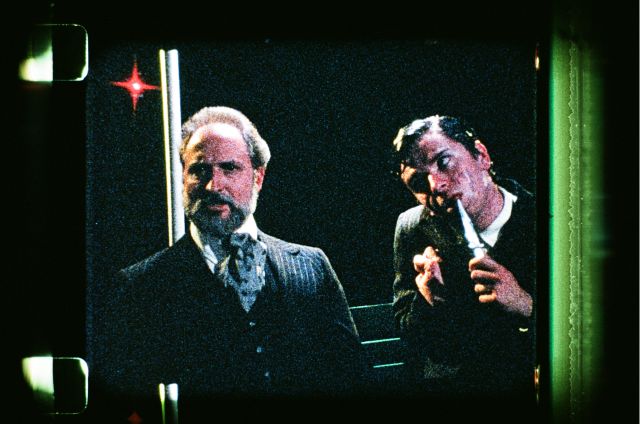The following is a chapter from my book Film: The Front Line 1983 (Denver, CO: Arden Press, 1983), a volume commissioned as the first in a projected annual series that would survey recent independent and experimental filmmaking. (A second volume, Film: The Front Line 1984, by David Ehrenstein, appeared the following year, but lamentably the series never continued after that, for a variety of reasons, even though both volumes remain in print.) I have followed the format used in both books.
It’s worth adding that De Landa abandoned filmmaking not long after this article appeared –- after planning, as I recall (but not shooting), a film starring his penis, to be entitled My Dick — and went on to pursue a distinguished academic career as a professor of art, architecture, and philosophy in New York, Pennsylvania, and Switzerland, with at least four books to his credit: War in the Age of Intelligent Machines (1991), A Thousand Years of Nonlinear History (1997), Intensive Science and Virtual Philosophy (2002), and A New Philosophy of Society (2006). For this reason, I couldn’t originally illustrate this piece with any images from his films, as I did in Film: The Front Line 1983, until some frame enlargements were recently made from Incontinence,a month after this article was originally posted, by Georg Wasner of the Austrian Film Museum, to use in a catalogue for a retrospective that I programmed (see below).Most of the other illustrations either come from more recent periods or are used to illustrate some commercial films that crop up in my discussion, e.g. Kiss Me Deadly and Bad Timing.
It’s regrettable that some of De Landa’s films aren’t available at present, but there are indications that some of these will start to become visible again after they’ve been restored. (Anthology Film Archives and the Austrian Film Museum have both shown some interest in doing this.) 2019: Raw Nerves can now be accessed online here.
I put this article into digital form in order to include it in a catalogue for “The Unquiet American: Transgressive Comedies from the U.S.,” a month-long retrospective I’ve curated for the Austrian Film Museum in October. Then, after discovering that the film I wanted to include, Incontinence, was unavailable, I initially had to remove this piece from the catalogue. But thanks to the indefatigible work of Regina Schlagnitweit, a print was found and the film was reprogrammed, so this essay was included in the catalogue after all. I also owe Regina, Georg Wasner, and the Austrian Film Museum many thanks for sending me the frame enlargements from Incontinence. —J.R.
Manuel De Landa
Born Mexico City, 1952
1975—Shit (Super-8, b&w, 30 min.) (unavailable)
1976—Song of a Bitch (Super-8, color, 30 min.) (unavailable)
1977—The Itch Scratch Itch Cycle (16mm, color, 8 min.)
1978—Incontinence: A Diarrhetic Flow of Mismatches (16mm, color, 18 min.)
1979—Ismism (Super-8, color, 8 min., silent)
1980—Raw Nerves: A Lacanian Thriller (16mm, color, 30 min.)
1981–Magic Mushroom Mountain Movie (Super-8, color, 8 min., silent)
1982–Massive Annihilation of Fetuses aka Judgment Day (former title: Micro Drama) (super-8, color, 7 min.)
–Harmful or Fatal if Swallowed (Super-8 blown up to 16mm, color & b&w, 12 min.) (incorporates footage from Shit and Song of a Bitch; original 8-minute, super-8 version, also 1982, unavailable)
An anarchist who studies analytical philosophy, Manuel De Landa makes aggressive, wild movies that simultaneously leap all over the place and stand absolutely still. His punchy Dada-like stances have a certain built-in versatility insofar as they manage to defy The System while both embodying and benefiting from it. As a charming middle-class Mexican in his early thirties who works on computer animation for TV commercials, and who recalls growing up in the most Americanized suburb of Mexico City, De Landa brings a certain Latin camp wit to his European theoretical models, from Wittgenstein to Deleuze and Guattari. A touch of the happy charlatan is similarly brought to his glitter punk credentials that hark back to such diverse Spanish-speaking surrealists as Arrabal, Buñuel, Dali, and Jodorowsky –- although, unlike most of his predecessors, De Landa prefers LSD and computers to the sacraments and anti-Christs of Catholicism in establishing the terms of his shock (and semi-mock) rebellion.
The spiritual son of Frank Zappa in more ways than one (who counts the early Mothers of Invention album We’re Only in it For the Money as a seminal influence), De Landa is up to his old demonic tricks even in his earliest films. The scatological frenzies of the street scenes in Harmful or Fatal if Swallowed –- a film that neatly encapsulates his seven-year oeuvre to date by recycling material from his two earliest works, which he made just after he came to New York from Mexico as a filmmaking student at the School for Visual Arts –-are as riddled with fancy optical transitions as The Itch Scratch Itch Cycle, a “study” for the much more ambitious look at bickering couples in Incontinence: A Diarrhetic Flow of Mismatches.
De Landa’s own theorization and description of the last two films is worth quoting in detail:
Part of the process of transplanting the narrative space of bourgeois theatre and novels to film involved learning to use off-screen space meaningfully. The main function assigned to it was the homogenization of the space of action. This is the subject matter of my first two films. In The Itch Scratch Itch Cycle the editing technique called “shot-countershot” is explored. The rhetorical figure is very important because it sutures the body of film. The film consists of five different versions of the same scene. The “real space” of a four-wall set is actually traversed by the camera in a figure-eight dolly movement around both characters in the first variation. The space thus produced is then subjected to extreme optical violence in each of the following variations which alter, one at a time, some of the principles on which the editing technique in question works (e.g., unity of point of view, unity of the scene depicted, relative plausibility of the angles of framing, etc.)
My second film, Incontinence, explores other rhetorical uses of editing which homogenizes film’s body, manipulating off-screen space. The use of matching techniques, particularly the so-called “sight-line matching,” makes heterogeneous and distant spaces look contiguous and as part of one unitary space.
In Incontinence, optical violence is done to matching techniques by forcing them to operate in extreme situations, but also to one of the main elements of their mechanism: the image of the body. Each one of the coordinates that guarantee the unity of a character’s body image is systematically altered. Thus the integrity of the image is destroyed by making it lose its size, change its relative position, vary in its permanence in time or space, switch identity, etc. This concerted destruction reaches its peak when one of the characters actually blows up.
In both The Itch Scratch Itch Cycle and Incontinence, the editing strategies parallel the depicted personal relationships every step of the way, and a mismatched cut is literally only the other side of a mismatched couple. (Hollis Frampton’s 1971 Critical Mass almost certainly exerted a strong influence, as did Yvonne Rainer’s latest features as well.) The willed perversity of the structures created defines the properties of De Landa’s jazzy style. The tacky settings and ugly male-female quarrels of both films are redolent of the campy Mexican effect, which is also underlined by the deliberately strident acting. (Among other aspects tying these two films together, both actors in the former, Susan Schneider and Rory Gerstle, appear in the latter, and the soundtracks for both films make prominent use of swing violinists.)
The crazy wipes that oscillate back and forth between separate shots –- as prominent here as they are in Raw Nerves and Harmful or Fatal if Swallowed –- deserve to be considered in some detail, for they all but constitute De Landa’s signature. (“Before coming to New York,” he has said, “I had developed a technique for hand-drawing wipes and other effects directly on the film, and I’ve used that technique in all my Super-8 and my 16mm films.”) One of his most original, striking, and seemingly radical devices — which at once foregrounds and undermines the very notion of transition by bobbing back and forth between shots like a needle stuck on a record, or a rat trapped on an endless treadmill –- it is, interestingly, one of the facets of his work that most suggests circularity and stasis, insofar as its violence against convention quickly becomes mechanistic, contained, and directionless, a sort of loop (or at best Möbius strip) of controlled aggression.
Incontinence was the first De Landa film that I encountered –- as part of the Whitney Biennial’s first film program, in 1979 –- and in some respects it remains the most impressive, bursting with inventiveness and energy. (J. Hoberman and I each nominated the film for a Soho News award that year as the best film by an emerging filmmaker, although the prize went to Grand Opera by James Benning (who later –- and understandably — complained about still being regarded by New Yorkers as “emerging”.) In place of the preceding film’s single couple are several couples whose quarrelsome dialogues are direct steals from the Edward Albee play Who’s Afraid of Virginia Woolf? The film also appropriates as soundtrack more modest chunks of Zappa’s We’re Only in it For the Money –- notably a brief composition consisting of overlapping peals of hysterical male laughter recorded at different speeds — and one might say that the spirit of Zappa is invoked throughout, particularly in the use of zany sound effects as interruptions to punctuate quick cuts.
Rarely have sound, image, and the spatio-temporal coordinates of narrative illusion been buffeted about as vigorously as in Incontinence, although the net effect of this violence may ultimately be no less circumscribed than the maelstrom inside a washing machine. Ordinary rules of spatio-temporal logic are repeatedly flaunted through the seesawing wipes and the uncanny transitions between scenes, so that, for instance, after an opening quarrel between a middle-aged couple, Rory Gerstle and Susan Schneider make their entrances by dropping successively from nowhere into a room. The latter significantly wears the same blue-green-purple blouse knotted at the midriff that she had on in The Itch Scratch Itch Cycle; the former turns up next in a restaurant scene, under characteristically chintzy lighting.
In the restaurant, the woman is called George, the man Martha, after Albee’s couple; the image splits in two, and a modern jazz number with vibes accompanies a slow dolly up to the table, turning romantic Hollywood “expressiveness” into a kind of delirium that’s as irrationally repetitive as the wipes between shots. Then the scene undergoes another dreamlike spatial transition when the camera follows a character into a park — without a clear division between interior and exterior –- where another Albee dialogue ensues between “George” and “Martha” (this time embodied by two men) on a park bench. One of the men is a grotesquely misshapen figure with a switchblade who suggests the psychotic hipster in Albee’s The Zoo Story, while a red light winks on and off in the background. Then Schneider drunkenly staggers past the men and the camera moves with her, leading back just as irrationally into a domestic interior — the same ghastly room with yellow walls, it seems, that we saw in The Itch Scratch Itch Cycle -– where she keeps popping in and out of the image while objects like a chair and cushion jiggle about in a pixillated frenzy.
Around this time, a suitcase is lowered into the room by rope, and out of it, thanks to camera magic, leaps a veritable Wild Man from Borneo — the infamous professor Mamboozoo (aka cartoonist Joe Coleman), an important De Landa collaborator whom we will encounter again. Mamboozoo promptly lights a fuse inside his shirt, which sets off a long string of firecrackers and seems to blow him up — achieving the apotheosis described above by De Landa –- after which he leaps about making diverse wild-man noises, moaning, etc….Later, there’s more or less more of the same, with Gerstle appearing in double exposure on a bike, and the percussively staccato, vamp-like intro to Zappa’s tune “Flower Punk” used to punctuate some of the more zany wipe effects.
The same year, De Landa completed the Super-8 Ismism he had started and worked on much earlier (between 1975 and 1978), a silent film that documents his own street graffiti in New York. Made originally for a course in language and film taught in 1976 by P. Adams Sitney, De Landa conceived of Ismism having “the form of a manifesto against the orthopedic power of language.” This manifesto essentially takes two forms: monstrously gaping lips, teeth, and eyes transplanted or transferred by De Landa from and to several commercial street posters, often framed in repeated zooms, and individual words painted on diverse street locations which are framed in static shots (like the individual letters in Hollis Frampton’s Zorns Lemma) and then strung together by the editing to spell out secret messages –- secret, that is, from the casual pedestrians who pass by the single words. These are messages, in short, that the filmmaker and film alone can articulate, in successive shots: “Unconscious/desire/expresses/itself /through/gaps/in/language,slips/ of/the/tongue…”; “Use/illegal/surfaces/for/your/art”; “Let/the/slang/of/ your/desires/drive/language/ crazy”– the latter of which could practically serve as De Landa’s motto. (Shortly before his twenty-third birthday, while spreading his graffiti around town, he was arrested for both defacement of public property and possession of marijuana, but released a few hours later, reportedly after De Landa insisted he was Puerto Rican. Almost six years later, at a nearly complete retrospective of his work at Millennium Film Workshop, he distributed Xeroxed copies of the police report as partial program notes.)
Raw Nerves: A Lacanian Thriller is De Landa’s most ambitious film to date; along with Incontinence, it also represents his best work. Conceptually, it has been described its maker as “my personal testament against psychoanalysis,” and, in fact, though few unalerted spectators would be likely to guess it without prompting, a polemical rethinking of the Oedipus complex does lie behind the film’s parodic noir structure and private-eye plot. But once again, we should give De Landa the microphone regarding the film’s intentions:
The film is an allegorical mise-en-scène of certain key concepts in contemporary psychoanalysis. It does not interpret or explicate those concepts; rather it enacts them. Whereas critical discourses often attempt to elucidate the structure of films by describing them in terms of some theoretical system, here the film operates as a dramatization of part of one of those systems. The result is not didactic. It does not add to the understanding of those concepts. It displaces them from the context where they are operative and inserts them in a narrative space where they can be properly misused.
Raw Nerves is the noir version of the Oedipus complex. The private eye personifies the Ego who narrates the story of how he learned language. Only in the film, instead of the traditional image of the castrated mother which is supposed to mediate the encounter with the Signifier (the Law), we have a secret message written on a public bathroom wall. Our hero is there, just taking a shit, when he suddenly sees it – he doesn’t know what it means but he knows he knows too much. So instead of having a private encounter with language in the coziness of the family, here it is the secret message which inserts the subject directly into the social project which preexists him and swallow him up without mercy.
Of course, throughout the movie the naïve Ego believes that he is telling us his story, that his speech merely expresses his intentions to communicate.
He will find at the end that the “secret meaning” was precisely that he has never spoken but that he was spoken by a strange object, decentered with respect to itself, which kils him after revealing him his truth.
Desire is made to circulate through six series parallel actions which function mainly metonymically, since the metaphorical point of convergence of the series, the point at which meaning arises, is indefinitely delayed.
It is interesting to find the secret messages of Ismism intersecting here with a (symbolic) infant’s first encounter with language. (An obsession with “codes” of all kinds runs through his work.) And De Landa’s insistence on the public over the private does indeed “interpret” and “explicate” certain psychoanalytical concepts, despite De Landa’s disclaimer (which characteristically allows him to work both sides of the street at once — that is, work both with and without the Lacanian paradigm). As De Landa said to me by way of further elaboration: “It’s just the situation of the baby when he sees a little girl or his mother walking around naked, and is going to try to deny and explain or rationalize the image of castration. Displacing the primal Oedipal scene from a private, middle-class warm space to a public, cold, wet public bathroom is a way of saying that your encounter with the symbolic, your access to language, is never a private little cozy event. Not even if you say first the family, then society –- not even that. Your father is always somebody else’s boss and servant –- there’s always the social field present.”
On a visceral level, Raw Nerves is almost as much of an assault as Incontinence, starting with the lurid, almost Day-Glo pinks, yellows, and slimey greens of the opening images, the brassy noirish music, and the customary abrasive wipes between alternating shots, which ultimately dissolve the distinctions between past, present, future, and subjunctive (as in Last Year at Marienbad) by placing everything on the same dubious, campy, and melodramatic level. A flashback via a snazzy, spiral-shaped wipe (the first of manu such cookie-cutter effects) leads to an overhead shot of the hero reading the coded message — obscene-looking hieroglyphics –- on a roll of toilet paper in front of him, which alternates with a frontal view of the same “primal scene”. (“The main point of the movie,” De Landa told me, “is that I’m defining the first signifier as the final scribble of a man who has just taken his last shit in this world.”) All this is set in hallucinogenic relief by greenish lighting and pink graffiti.
The ensuing paranoid plots owes a lot to both Kiss Me Deadly and the Mickey Spillane novel it’s based on (which furnishes part of the dialogue –- although the script is credited to Joan Braderman, Paul Arthur, and De Landa, among others), with iconographic (and graphic) lifts from other Forties and Fifties noir as well: shadowy grill patterns on walls, colors like the inside of a fruity Fifties jukebox. In a surprise ending, the off-screen narrating voice of the hero proves to belong to a woman, who declares, “Never trust a first person pronoun” before shooting him dead.
Shot at the School of Visual Arts (like The Itch Scratch Itch Cycle and much of Incontinence), De Landa’s private eye saga is enhanced by its technical polish, ascribable in part to the excellence of Bill Brand’s optical printing. That one of De Landa’s ambitions is to crack Hollywood can easily be deduced by the film -– not only because of the technique, but also because of the noir trappings, the most conventional aspect of the film. (The confrontation of Freud with Sherlock Holmes, imagined in mainstream terms by The 7 ½ % Solution and in arthouse terms by Bad Timing, is also one of the most popular idioms to hit the American avant-garde and independent film in the Seventies –- as trendy as political/avant-garde films about vampires were in the Sixties, especially in Europe and Latin America. By the early Eighties, the confluence of psychoanalysis and detection can be said to have formed a subgenre in its own right, thereby shrewdly tempering De Landa’s originality with something more familiar and less threatening to resonate against.)
1981 saw the completion of only one De Landa film — Magic Mushroom Mountain Movie, an eight-minute, Super-8 digest of De Landa’s annual visits to a peyote cult family in Huaulta, “a tiny little town in the middle of La Sierra Mazateca in Mexico”. This color, sound film lodges itself in the memory as a kind of documentary impressionism, meditative and suggestive in its hallucinatory moods rather than hyperventilated in the usual De Landa manner.
On April 30 of the same year, De Landa put on a notorious live performance at The Kitchen in lower Manhattan which deserves some mention here. Appearing in a program held under the auspices of Semiotext(e) magazine, in conjunction with a recent issue on polysexuality, De Landa hired Professor Mamboozoo to join him and contribute his own forms of dada assault. After lying to the show’s organizers (De Landa said he would appear with paper-maché sex organs), the two concocted a sort of voodoo ceremony under Mamboozoo’s guidance that involved a double-barrel shotgun loaded with blanks, the freshly decapitated heads of a cow and a pig (purchased from a New Jersey slaughterhouse), and large quantities of snakes, frogs, mice, and crickets in boxes that were released in (or thrown at) the audience after the shotgun was fired.
“Now that’s all that was in the script,” De Landa recalls.”But of course Professor Mamboozoo had to do something that would shock me, his assistant, too. So at this point I had the snakes and frogs, and he had the mice. They started to crawl on him and bite him –- we had to give him some rabies shots afterwards –- so he starts biting back, and biting their heads off.” By this time, needless to say, most of the audience had fled the premises. “It is fascism in a way,” De Landa admits now of the performance, “in the sense that you’re attacking people. Someone could have died that night.” Despite this (once again) characteristic disclaimer, De Landa got all the publicity and notoriety he wanted from the event, which continues to fuel his legend.
The seven-minute Massive Annihilation of Fetuses –- originally entitled Micro Drama, more recently announced as the first part of The Jerry Falwell Series (with a title deriving from Falwell) -– is almost as grungy in a way, and easily just as apocalyptic. “The film is my tribute to the real master race that will soon inherit the planet,” De Landa has explained. “Cockroaches have not only invaded the flip side of my house (i.e., the back of my kitchen, the other side of my walls, etc.) but they have also taken over some areas of my unconscious….Since I started the film the structure of my nightmares has changed, almost as if I had violated their laws and they were getting ready for revenge.”
Sounds of eerie yells and screams on the soundtrack (electronically developed out of De Landa and Joan Braderman’s voices) accompany shots of cockroaches in close-up as well as in long shot, skittering about. Eventually, afflictions of an almost Biblical nature are visited upon them by an offscreen De Landa playing God (revealing that his “tribute” is actually a form of revenge in advance for a species that, unlike mankind, might survive a nuclear holocaust): a slab of striped toothpaste falls on one, a fork prong and a screw successively crush two more; others are drowned in honey, sliced by a razor, and lit by a match.
Harmful or Fatal if Swallowed — reportedly screened to loud boos at the New York Film Festival, where it was shown with the more hospitably received Vortex (by Beth B and Scott B) –- is in a way just as conventional a film, a kind of compendium of scatological street humor that has been a staple of the more commercial New York independents (from Robert Downey to John Waters) for at least two decades. With its Ballet méchanique tropes (e.g., two businessmen walking forward and backward to a Strauss waltz), customary zany wipes, defecating dogs, fish-eye-lens-views of pedestrians, electronic bleeps and heavy percussion on the soundtrack, edited alternations between consumptions of hot dogs and excretions of dog turds, it encapsulates an entire history of flaky adolescent city humor with a great deal of facility, but much less inventiveness than one would be apt to find in any of De Landa’s other films. Intercutting several pedestrians looking in a shop window with snippets of hardcore porn footage is one of the more hackneyed devices, but there are others just as conventional.
According to De Landa, there is an “extra-strength Tylenol version” of the film, slightly longer and seldom shown, which presents Professor Mamboozoo improvising a racist and sexist rant, a sequence he was persuaded to cut from the film before it was shown publicly, in the fear that it might wind up alienating everyone (as it was presumably meant to do). The paradox in this act of self-censorship –- which De Landa himself seems less than perturbed about — appears entirely fitting, in a way, for a brilliant and talented filmmaker with an asocial image to sell and a highly social way of putting it across, a theorist who could write a careful academic paper about “Wittgenstein at the Movies” at the same time that he encourages us all to dream of destruction. Working both sides of the traffic with a gleam in his eye, De Landa knows how to play it hard and easy with alternating pedals, carrying us everywhere and nowhere at once in an awful hurry.
—Film: The Front Line 1983; slightly revised in 2009


